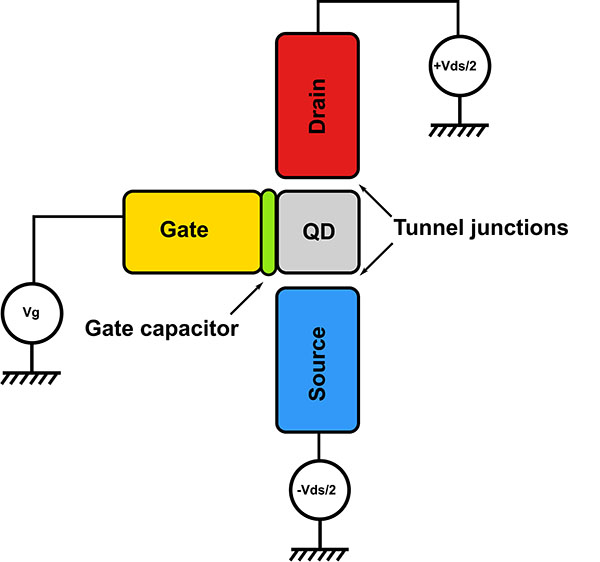Single-Electron Transistors: The Ultimate in Miniaturization and Precision
What is a Single-Electron Transistor?
A single-electron transistor (SET) is a nanoscale electronic device that allows the precise control of individual electrons. Unlike conventional transistors that rely on the flow of many electrons, SETs operate by manipulating the movement of a single electron at a time. This extreme level of control enables SETs to achieve unprecedented levels of miniaturization, sensitivity, and energy efficiency.

Key Concepts in Single-Electron Transistors
The operation of SETs relies on several fundamental concepts:
- Coulomb Blockade: Coulomb blockade is the key principle behind the operation of SETs. It refers to the suppression of electron flow through the device due to the electrostatic repulsion between electrons. When the charging energy of adding an electron to the island is greater than the thermal energy, the flow of electrons is blocked, allowing for precise control over individual electron transport.
- Quantum Dots: SETs typically employ quantum dots, which are nanoscale structures that confine electrons in all three spatial dimensions. These dots act as the conducting island in the SET and can be made from various materials, such as semiconductors, metals, or molecules. The size and shape of the quantum dot determine its electronic properties and the SET's characteristics.
- Tunnel Junctions: SETs rely on tunnel junctions to connect the quantum dot to the source and drain electrodes. These junctions are thin insulating barriers that allow electrons to tunnel through them when a voltage is applied. The tunnel junctions play a crucial role in controlling the flow of electrons and enabling the Coulomb blockade effect.
Operating Principle of Single-Electron Transistors
The operation of a SET involves the following steps:
- An electron tunnels from the source electrode onto the quantum dot when a voltage is applied between the source and drain electrodes.
- The presence of the electron on the quantum dot increases the electrostatic potential, preventing additional electrons from tunneling onto the dot due to Coulomb blockade.
- By applying a voltage to the gate electrode, the electrostatic potential of the quantum dot can be modified, allowing for the precise control of the electron flow through the device.
- As the gate voltage is varied, the SET exhibits periodic conductance peaks, known as Coulomb oscillations, which correspond to the addition or removal of individual electrons from the quantum dot.
This ability to control the flow of individual electrons makes SETs highly sensitive to changes in their environment, such as temperature, magnetic fields, and chemical species. As a result, SETs have found applications in various fields, including ultra-sensitive sensors, quantum computing, and low-power electronics.
Fabrication of Single-Electron Transistors
The fabrication of SETs requires precise control over the nanoscale structure and dimensions of the device. Several techniques have been developed for the fabrication of SETs:
- Electron Beam Lithography: Electron beam lithography is a high-resolution patterning technique that uses a focused electron beam to define the nanoscale features of the SET. This method allows for the precise control of the quantum dot size and the tunnel junction dimensions, enabling the fabrication of high-quality SETs.
- Self-Assembly: Self-assembly techniques rely on the spontaneous organization of nanoscale building blocks, such as nanoparticles or molecules, to form the SET structure. This approach offers the potential for large-scale, low-cost fabrication of SETs but often requires careful control over the self-assembly process to ensure device uniformity and reliability.
- Scanning Probe Lithography: Scanning probe lithography techniques, such as atomic force microscopy (AFM) or scanning tunneling microscopy (STM), use a sharp probe to directly manipulate or pattern the nanoscale features of the SET. These methods offer high resolution and flexibility but are typically limited to small-scale fabrication.
Applications of Single-Electron Transistors
SETs have the potential to revolutionize various fields due to their unique properties and capabilities:
Ultra-Sensitive Sensors
SETs are extremely sensitive to changes in their environment, making them ideal candidates for ultra-sensitive sensors. They have been used to detect single electrons, single photons, and single molecules, enabling applications in chemical and biological sensing, quantum metrology, and high-resolution imaging.
Quantum Computing
SETs are promising building blocks for quantum computing, where the quantum states of individual electrons can be used to represent and manipulate quantum bits (qubits). The ability to precisely control and read out the state of individual electrons in SETs makes them attractive for realizing scalable quantum computing architectures.
Low-Power Electronics
The operation of SETs at the single-electron level enables ultra-low power consumption, making them potential candidates for energy-efficient electronic devices. SETs could be used in low-power sensors, switches, and memory devices, contributing to the development of sustainable and green electronics.
Challenges and Future Perspectives
Despite the promising potential of SETs, several challenges need to be addressed for their widespread adoption. One of the main challenges is the operation of SETs at room temperature, as the Coulomb blockade effect is typically observed at cryogenic temperatures. Researchers are exploring new materials, device architectures, and fabrication techniques to extend the operating temperature range of SETs.
Another challenge is the integration of SETs with existing electronic technologies. The development of hybrid systems that combine SETs with conventional transistors and circuits is an active area of research, aiming to leverage the unique capabilities of SETs while maintaining compatibility with established manufacturing processes.
Future research on SETs will focus on improving device performance, reliability, and scalability. The exploration of novel materials, such as 2D materials and topological insulators, could lead to new opportunities for SET-based devices. Additionally, the integration of SETs with other emerging technologies, such as spintronics and photonics, could enable novel functionalities and applications.
Further Reading
Microsystem Technologies, Single-electron transistor: review in perspective of theory, modelling, design and fabrication
2013 IEEE International Conference ON Emerging Trends in Computing, Communication and Nanotechnology (ICECCN), Single Electron Transistor theory: A review
19th International Conference on Synthesis, Modeling, Analysis and Simulation Methods and Applications to Circuit Design (SMACD), Single-Electron-Transistor Compact Model for Spin-Qubit Readout
